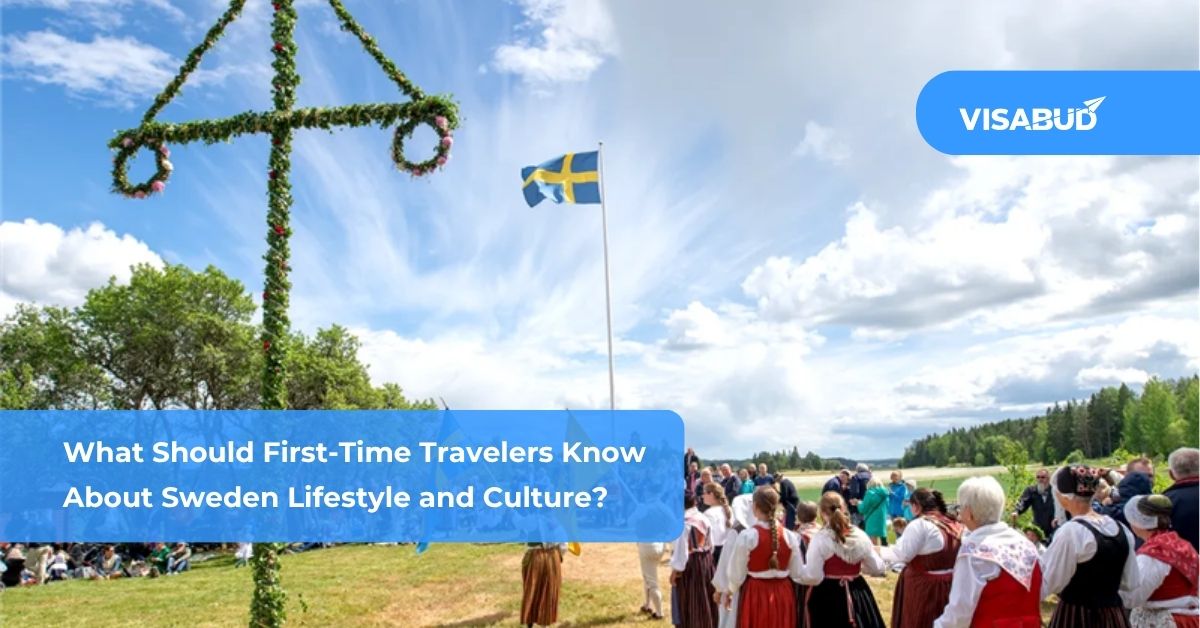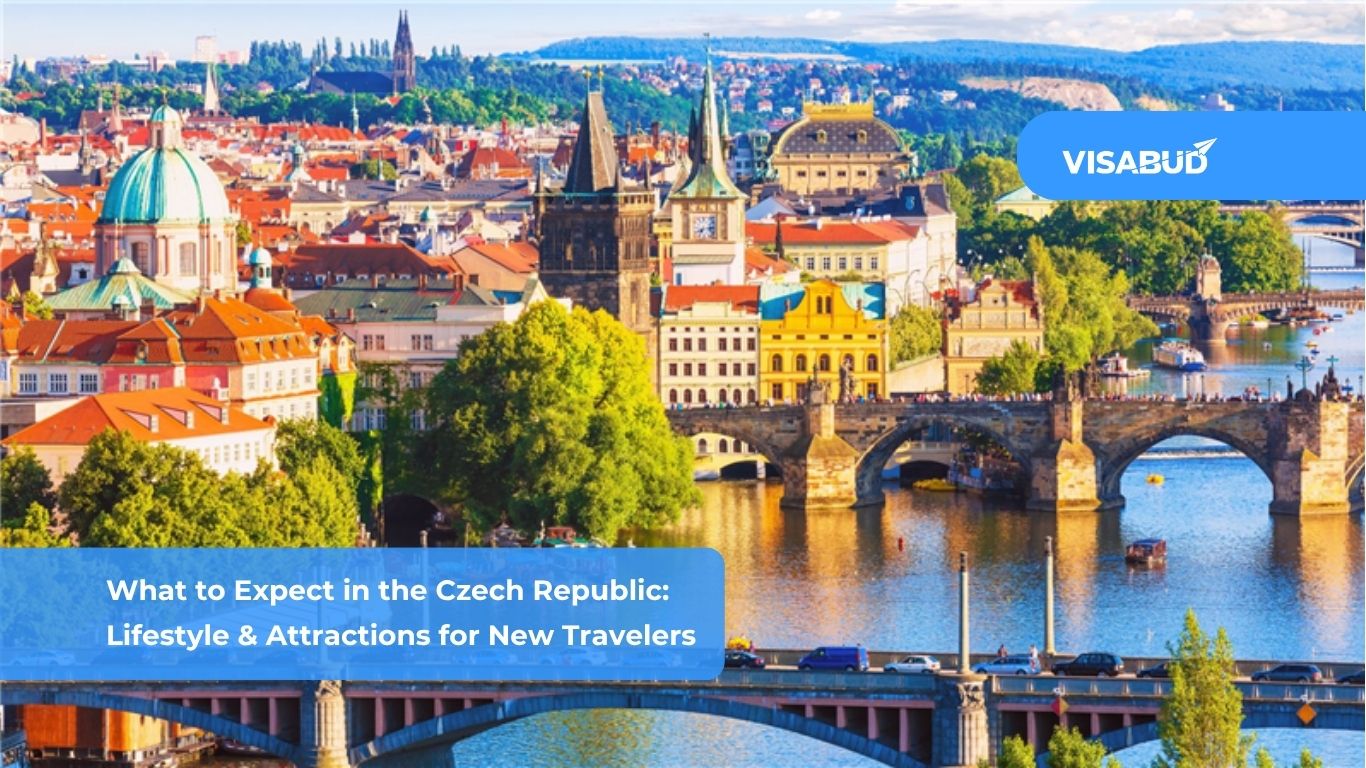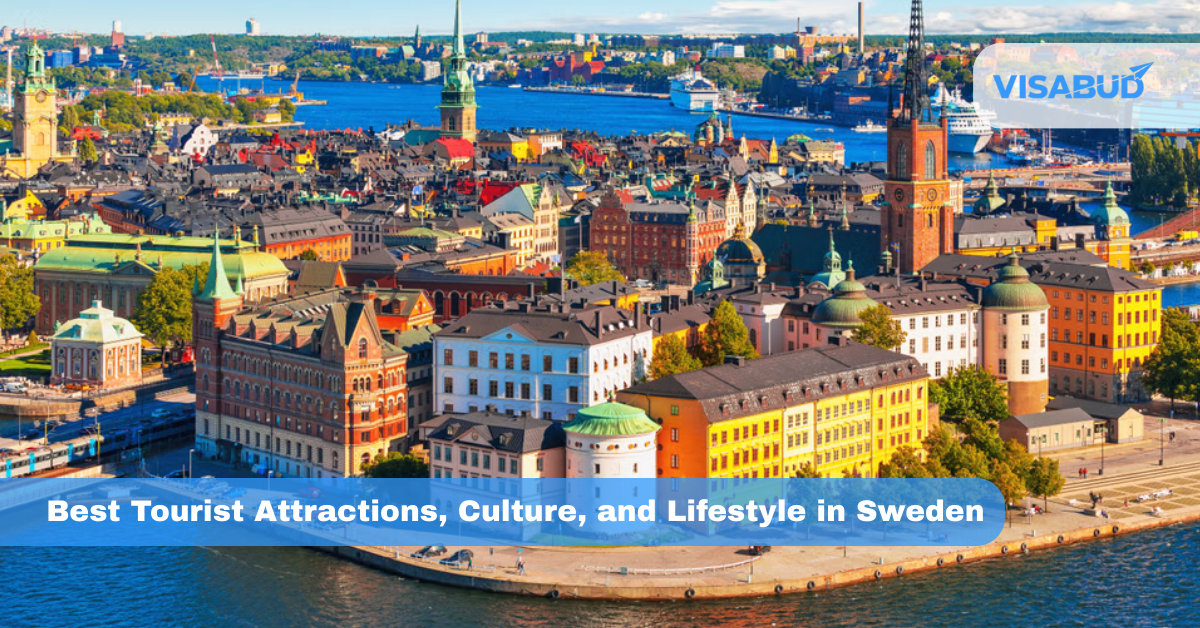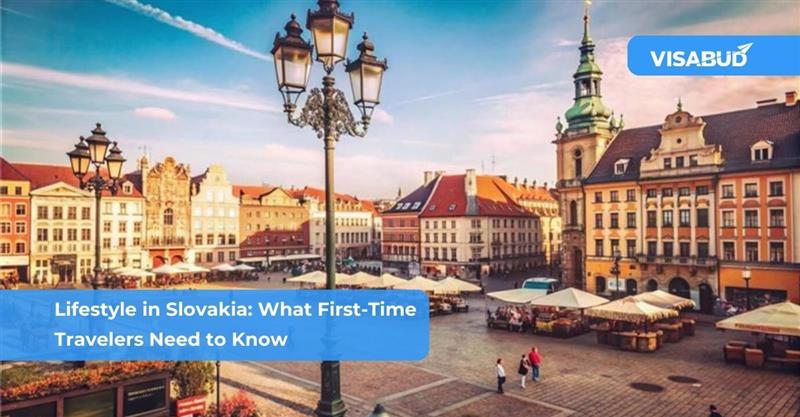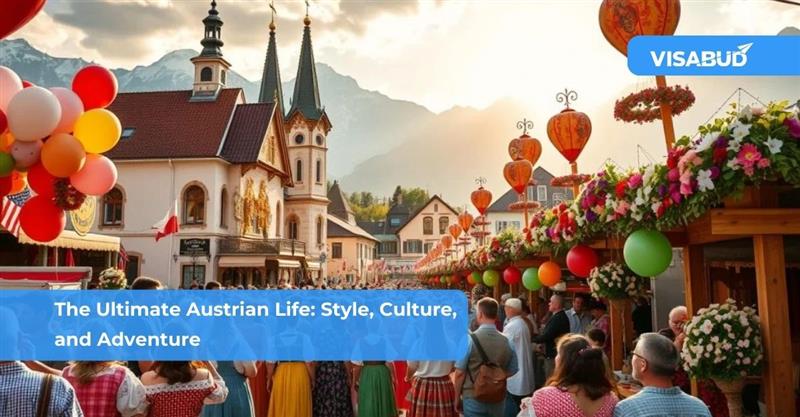Sweden is a way of life, not just a place to visit. From its quiet forests and mirror-like lakes to its sleek architecture and people-first cities, Sweden offers a calming yet fascinating experience for first-time travelers. Whether you’re visiting Stockholm’s waterfront cafes, exploring the northern lights in Lapland, or enjoying the summer sun in Gothenburg, the Swedish lifestyle leaves a lasting impression.
At its core, Sweden is a nation that thrives on balance. The idea of lagom not too much, not too little, just right is what the locals live by. This idea influences everything, from work hours to social gatherings, and even the design of everyday spaces. For visitors, it means you’ll find a country where things feel calm, efficient, and respectful, perfect for anyone looking to slow down and savor the moment.
One of the most delightful cultural rituals is fika, a daily coffee break that’s less about caffeine and more about connection. Sitting down for a cinnamon bun and conversation isn’t just encouraged it’s part of the social fabric. It’s small touches like this that make Sweden feel inviting, even to newcomers.
First-time travelers should also prepare for a society that values personal space, equality, and sustainability. Swedes might come across as reserved at first, but they’re warm-hearted and helpful once you engage sincerely. Many speak fluent English, and they’re proud to share their culture especially if you show an interest.
Understanding a few basics about Swedish etiquette, food culture, and daily life will help you blend in and feel more at home. And the more you tune into Sweden’s rhythm, the more rewarding your travel experience will be.
So, if you’re planning your first trip to Sweden, get ready not just to visit but to feel part of something beautifully balanced and deeply human.
Embracing the Swedish Way of Life: Lagom and Fika Explained
Sweden is famous for its stunning nature, modern design, and high quality of life. But what truly defines the Swedish way of life are two simple yet powerful cultural concepts: Lagom and Fika. For first-time travelers, understanding these traditions can make your visit more meaningful and help you connect with locals on a deeper level.
1. Lagom: The Art of Balance
At the heart of Swedish culture lies the idea of lagom, a word that means “just the right amount.” It’s not about excess or scarcity but finding a perfect balance in all aspects of social interaction, employment, pleasure, and consumption.
Lagom promotes leading a harmonious and sustainable existence. It’s why Swedes tend to prioritize work-life balance, ensuring they have enough time to relax, spend time with family, and enjoy nature. You’ll notice it in their homes, which are often simple and cozy, focused on functionality and comfort rather than extravagance.
For travelers, adopting the lagom mindset can help you slow down and appreciate your surroundings without rushing. Instead of cramming your itinerary with nonstop sightseeing, take time to enjoy each moment fully whether it’s a quiet walk in a park or a leisurely meal.
This philosophy extends to how Swedes consume goods and resources. They prefer quality over quantity and take great care to minimize waste and live sustainably. Recycling is a big part of everyday life, and many Swedes choose eco-friendly options whenever possible.
Understanding lagom also means respecting Swedish social norms. Swedes value peace and personal space and are generally courteous yet reticent. So, when visiting, give people their space and avoid being overly loud or intrusive.
2. Fika: More Than Just a Coffee Break
If lagom is about balance, then fika is about connection. Fika is a beloved Swedish tradition that involves taking a break to enjoy coffee or tea with a pastry, usually shared with friends, family, or colleagues.
However, fika is much more than just a coffee break. It’s a cultural ritual that represents slowing down, socializing, and appreciating the small joys in life. Whether at work, at home, or in a café, Swedes make time for fika at least once or twice a day.
Participating in fika during your trip is a wonderful way to experience Swedish culture firsthand. You can visit a local café and try classic pastries like cinnamon buns (kanelbullar) or cardamom rolls, paired with strong, freshly brewed coffee.
Fika is more than just food and beverages; it is about taking a time to relax, refuel, and socialize. It highlights the significance of relationships and well-being, as well as the Swedish concept of work-life balance.
Why Lagom and Fika Matter for Travelers
For first-time visitors, these two cultural practices are key to understanding Sweden beyond its beautiful scenery and landmarks. Embracing lagom encourages you to pace your trip thoughtfully and enjoy it without stress. Meanwhile, joining in fika opens doors to social experiences and helps you feel more at home.
By slowing down, respecting social boundaries, and savoring everyday moments, you’ll find your visit richer and more rewarding.
Tips for Practicing Lagom and Fika on Your Trip
Navigating Social Norms and Etiquette
Traveling to a new country comes with a sense of adventure, but it also calls for cultural awareness. Sweden, known for its clean cities, beautiful landscapes, and progressive values, also has a well-defined set of social norms that guide everyday life. For those visiting Sweden for the first time, understanding and respecting these unwritten rules is a vital step in feeling comfortable and being well-received by locals. Three major components of Swedish etiquette stand out: punctuality, respect for personal space, and an orderly queuing culture. Let’s take a closer look at these aspects to help you blend in and enjoy your journey.
The Importance of Punctuality in Swedish Society
One of the most noticeable social expectations in Sweden is punctuality. Being on time is more than just good manners; it reflects how seriously you take your commitments and how much you respect the other person’s time. In Swedish culture, timekeeping is not flexible or negotiable. Whether you’re attending a job interview, a business meeting, or even a casual meet-up with friends, it is expected that you arrive at the agreed time, or preferably, a few minutes early.
Unlike some cultures where being fashionably late is acceptable or even expected, tardiness in Sweden can leave a negative impression. People plan their days precisely, and even a short delay can disrupt that rhythm. This respect for time also applies to public transport, where buses, trains, and trams operate on strict schedules, and passengers are expected to be ready and waiting before departure. If, for any reason, you are running late, sending a text or calling ahead to notify the other person is considered courteous and shows that you care.
Punctuality is deeply rooted in the Swedish value of equality; everyone’s time is considered equally important. Honoring time commitments means participating in a social contract of mutual respect. As a traveler, taking punctuality seriously will help you make a positive impression, be welcomed warmly in both personal and professional settings, and navigate day-to-day interactions smoothly.
Understanding Personal Space and Quiet Politeness
Another key cultural trait in Sweden is the high regard for personal space. Swedes tend to be reserved in public and are not typically expressive through physical touch or loud conversation. They value quietness and personal boundaries, and they are especially mindful of giving others enough space in both physical and social settings. This preference can initially come off as distant or cold to visitors from more expressive cultures, but it is not meant to be unfriendly it’s simply how Swedes demonstrate respect.
In everyday situations like waiting for the subway, sitting on a bench, or talking in a café, people generally maintain a comfortable distance from each other. Public transport etiquette includes avoiding sitting directly next to someone if there’s an open seat elsewhere. In conversations, Swedes are generally soft-spoken and tend to pause between sentences without feeling the need to fill the silence. These pauses are not uncomfortable for them; in fact, silence is appreciated and often indicates thoughtfulness.
For travelers, it’s important to be mindful of this unspoken rule. Avoid speaking too loudly in public spaces, and try not to engage in overly animated behavior, especially in places like libraries, public transport, or queues. Physical contact such as hugging, back-patting, or touching someone’s arm while talking is usually reserved for close friends and family, not acquaintances or strangers. Respecting personal space shows your understanding of the culture and signals that you are considerate of social norms.
Over time, as you build rapport with locals, you may notice a shift. Swedes might become more outspoken, open up, and participate in conversations more fully. This gradual approach to socializing stems from a culture that prioritizes sincerity and depth in relationships rather than surface-level friendliness. So, while first impressions might feel distant, patience and genuine interest can lead to meaningful connections.
The Quiet Discipline of Queuing in Sweden
In Sweden, orderliness is deeply ingrained in daily life, and one of the clearest expressions of this is how people queue. Whether at a supermarket, bank, pharmacy, or even a bus stop, you will see people lining up patiently, waiting their turn. It’s not just a habit; it’s a cultural expectation. Jumping the line or trying to cut ahead is considered disrespectful and rude, even if done unintentionally.
Many service establishments in Sweden use ticketing systems to manage queues. When you enter, you’ll often find a small machine dispensing numbered tickets. You simply take one and wait for your number to be called or displayed. This helps maintain fairness and efficiency without anyone needing to verbally assert their place in line. Even without a ticket system, people usually know who is next by memory or by politely asking “Vem är sist?” which means “Who’s last?”
One notable aspect of queuing in Sweden is how peaceful and quiet it is. People wait without pushing, crowding, or showing impatience. Even in busy places, the atmosphere remains polite and composed. This etiquette applies equally in informal settings like food trucks or ferry terminals and is followed by people of all ages.
In addition to making you fit in, visitors can avoid awkward situations by adjusting to this tidy behavior. Being mindful of your place in line, respecting the system, and avoiding attempts to rush service will demonstrate that you value the local customs. It’s also a great way to experience the Swedish sense of mutual respect in action, where everyone’s time and needs are treated with fairness.
Discovering Swedish Dining and Culinary Traditions
Experiencing the culture of a country often begins at the dining table, and in Sweden, food reflects far more than just flavor. It tells a story of simplicity, seasonality, and togetherness. For first-time travelers, understanding Swedish cuisine and mealtime customs can provide a deeper connection to the local way of life. From iconic dishes like meatballs and pickled herring to unspoken rules about dining etiquette and tipping, there’s much to appreciate and learn.
The Character of Swedish Cuisine: Simplicity, Freshness, and Comfort
Swedish food is known for its clean flavors, seasonal ingredients, and wholesome approach to cooking. Unlike heavily spiced or complex cuisines, Swedish cooking celebrates the natural taste of ingredients, letting each component speak for itself. It is a cuisine grounded in tradition but shaped by nature, geography, and resourcefulness.
One of the most iconic dishes in Sweden is köttbullar, or Swedish meatballs. Often served with creamy mashed potatoes, rich gravy, lingonberry sauce, and lightly pickled cucumber, these meatballs are a favorite among locals and tourists alike. While IKEA made them famous globally, homemade versions and local restaurant offerings are far more flavorful and satisfying.
Pickled herring, or sill, is another traditional staple. It’s commonly found on holiday smorgasbords, particularly during Midsummer, Christmas, and Easter. Served in a variety of marinades — from mustard and dill to onion and garlic — sill is usually accompanied by boiled potatoes, crispbread (knäckebröd), sour cream, and chopped onions. For newcomers, it may be an acquired taste, but it’s a deeply rooted part of Sweden’s culinary identity.
Then there is the well-known smörgås, a sandwich with an open face that exemplifies Swedish simplicity. Topped with ingredients like cheese, cold cuts, shrimp, egg, and dill, smörgås is typically eaten for breakfast or lunch. It’s fresh, light, and easy to customize — perfectly in line with Sweden’s love of moderation and balance.
Seafood plays a central role in Swedish cuisine due to the country’s long coastline and abundance of lakes. Salmon, shrimp, crayfish, and cod appear in many popular dishes. Crayfish parties (kräftskiva) in August are especially fun cultural events where friends gather to eat boiled crayfish, sing traditional songs, and enjoy the late summer nights.
You’ll also notice that dairy products, potatoes, berries, and root vegetables appear frequently in meals, especially in home-cooked food. Even in modern dishes, there’s a strong appreciation for preserving Sweden’s culinary heritage, often with a twist of contemporary presentation.
Dining Etiquette: How to Eat Like a Local
Dining in Sweden isn’t overly formal, but there are a few cultural cues worth understanding to make sure you’re in sync with the locals. Mealtime is not just about eating — it’s about respect, presence, and community. Whether you’re dining at someone’s home, in a restaurant, or at a festive celebration, following certain etiquette helps you show appreciation for the moment.
One of the most important rules to remember is to wait for the host to begin the meal. Even in informal settings, it’s common to pause before starting, often with someone saying a short phrase like “Varsågod” (meaning “please, go ahead”) or “Smaklig måltid” (enjoy your meal). This small act sets the tone of gratitude and mindfulness around food.
At the table, it is customary to keep your hands visible above the table, resting your wrists or forearms rather than hiding your hands on your lap. This isn’t about control or tradition for the sake of it — it’s seen as polite and engaged behavior. Swedes generally use utensils for most meals, including using a fork and knife for foods that in some cultures might be eaten by hand. Table manners are subtle but observed.
Toasting is another cherished part of Swedish dining culture. When someone raises a glass and offers a toast, it’s important to make eye contact with the other guests, smile, and respond with a heartfelt “Skål!” — Sweden’s equivalent of “Cheers!” This eye contact is a sign of inclusion and trust, not just a formality.
Swedes typically don’t linger at the dinner table for hours unless it’s a special occasion, but they do value meaningful conversation and shared time. Meals are often calm, thoughtful, and focused on the food and company. Interrupting or speaking loudly over others is discouraged.
Tipping in Sweden: Thoughtful, Not Mandatory
Unlike in some countries where tipping is expected and even built into the pay structure of service workers, tipping in Sweden is not obligatory. Service charges are typically included in the bill at restaurants, and servers earn fair wages regardless of tips.
That said, tipping is still appreciated, especially if the service was warm, attentive, or exceeded expectations. A common practice is to round up the bill to the nearest 10 or 20 kronor, or to leave a small amount of change — perhaps 5–10% of the total — as a gesture of gratitude. You’re not likely to offend anyone by not tipping, but you will make a server’s day with a modest token of appreciation.
Tipping is considerably more casual in cafés and casual dining establishments. Many places will have a small jar near the counter for coins or bills, but there’s absolutely no pressure. Tipping is also uncommon for taxi rides or fast food, though again, rounding up the fare is considered polite.
For travelers, this creates a low-pressure environment when dining out. You can focus on enjoying your meal without the stress of calculating a tip, and simply offer a small thanks when it feels right.
Exploring Sweden’s Natural Beauty and Cultural Traditions
Sweden, a land of majestic landscapes and rich traditions, offers first-time travelers an unforgettable blend of natural beauty, seasonal wonders, and meaningful cultural experiences. Whether you’re hiking through pristine forests, dancing under the Midnight Sun, or sipping coffee during a cozy winter fika, Sweden invites you to slow down, embrace the moment, and experience life the Swedish way. In this guide, we explore essential aspects of Swedish nature, cultural customs, and practical travel tips to help you enjoy a smooth, immersive journey.
Allemansrätten: Sweden’s Unique Right to Nature
One of Sweden’s most treasured cultural principles is “Allemansrätten,” which translates to “everyman’s right.” This law allows everyone to access and enjoy the countryside freely. It is a deeply ingrained cultural attitude that prioritizes harmony with nature, not just a norm. Whether you’re hiking through the forests of Dalarna, kayaking along a quiet lake, or setting up a tent in the north, this right encourages people to connect with the land without fences or limitations.
However, with freedom comes responsibility. Visitors to Allemansrätten must be mindful of the environment. That means not disturbing wildlife, not littering, and respecting the privacy of rural residents. The respect Swedes show for their environment is infectious. Travelers often find themselves more mindful and appreciative of their surroundings, learning not just how to enjoy nature, but how to protect it.
Seasonal Highlights: From the Midnight Sun to the Northern Lights
Sweden’s seasons are more than just changes in temperature; they are dramatic shifts that shape daily life, traditions, and natural experiences. In summer, particularly in regions above the Arctic Circle like Kiruna or Abisko, the sun barely sets. This phenomenon, known as the Midnight Sun, creates a magical atmosphere where outdoor activities continue late into the night. People gather at lakes, hike through alpine trails, and enjoy long, golden evenings that seem to stretch forever.
In stark contrast, winter turns Sweden into a snow-blanketed wonderland. This is when you can witness the awe-inspiring Northern Lights, especially in Swedish Lapland. The sky dances with green and purple hues, drawing photographers and nature lovers from all over the world. Winter also brings cozy traditions such as drinking warm glögg, ice skating on frozen lakes, and staying in uniquely designed ice hotels.
Autumn in Sweden is a quiet, introspective season. The forests turn vivid shades of orange and red, and it becomes mushroom and berry foraging season. Meanwhile, spring is when life begins to bloom again, and locals start preparing their summer cottages for the warmer months. Every season offers a new lens through which to experience Sweden’s diverse landscapes and cultural rhythm.
Celebrating Swedish Traditions: Midsummer and Lucia Day
Sweden’s festivals are reflections of its connection to both nature and community. One of the most iconic is the Midsummer Festival, celebrated in late June. For many Swedes, Midsummer rivals Christmas in importance. Families and friends gather outdoors to dance around the maypole, sing age-old songs, and share a meal featuring fresh seasonal produce like pickled herring, potatoes, strawberries, and snaps (a flavored spirit enjoyed with songs). Midsummer is a happy time, full of flower crowns, laughter, and a mutual appreciation of summertime bounty and sunshine.
In contrast, Lucia Day on December 13th offers a moment of serenity during Sweden’s darkest time of year. Saint Lucia, a representation of hope and light, is honored in this event. Young girls dressed in white gowns, with one wearing a crown of candles, lead processions through schools, churches, and communities. They sing traditional hymns and hand out saffron buns and ginger cookies. Lucia Day is a gentle, beautiful reminder of warmth and light during the long Nordic winter.
Practical Tips for a Seamless Swedish Adventure
For a stress-free visit to Sweden, it helps to understand a few key aspects of modern Swedish life. First, Sweden is largely a cashless society. Credit and debit cards, as well as mobile payment apps like Swish, are widely used across restaurants, shops, and even street markets. Some places may not accept cash at all, so carrying a working card is essential. This digital-first approach makes transactions fast, simple, and secure.
Another helpful tip is to be aware that while Swedish is the official language, English is spoken fluently by a majority of the population, especially in cities and tourist areas. You won’t have much trouble communicating, but learning a few basic Swedish phrases like “hej” (hello), “tack” (thank you), and “ursäkta” (excuse me) can go a long way in showing appreciation for the culture.
Sweden is also one of the most environmentally conscious countries in the world. Recycling is part of daily life, and you’ll notice separate bins for paper, plastic, food waste, and more in both public and private spaces. Public transport, including trains, trams, and ferries, is designed with sustainability in mind. Travelers are encouraged to use public transportation or rent bikes rather than rely on cars. Even hotels and restaurants participate in green initiatives, from offering locally sourced meals to minimizing single-use plastics.
The Swedish Lifestyle: Where Nature and Modernity Coexist
At the heart of Sweden’s lifestyle is the effortless blend of modern living with deep respect for nature and tradition. Whether you’re walking through the contemporary streets of Stockholm or enjoying a quiet moment in a rural forest, you feel the balance. Swedes prioritize health, sustainability, and personal well-being, values that are visible in everything from the way they structure their workdays to how they spend their weekends.
Taking time for oneself is not a luxury but a part of everyday life. The concept of “lagom,” meaning “just the right amount,” influences how people eat, work, decorate their homes, and socialize. Similarly, “fika,” the daily coffee break often enjoyed with pastries and friends, is a reminder that slowing down is not only acceptable but encouraged. These elements of Swedish life add richness and meaning to the visitor experience, inviting travelers not just to see Sweden, but to live a little like a Swede while they are there.
Whether you’re chasing the Northern Lights, joining a Midsummer dance, or enjoying a calm ferry ride through the Stockholm archipelago, every moment in Sweden is an invitation to engage more mindfully with your surroundings. For travelers seeking authenticity, inspiration, and serenity, Sweden is not just a destination—it’s an experience shaped by nature, culture, and a deeply rooted way of life.
FAQ: What Should First-Time Travelers Know About Sweden Lifestyle and Culture?
1. What’s the typical way to greet people in Sweden?
Swedes keep greetings simple. A friendly handshake and a soft “Hej” (pronounced like “hey”) is all you need. They don’t usually go for hugs or cheek kisses unless you’re already close friends.
2. How important is coffee in Swedish culture?
Very important! The concept of fika—a coffee break with pastries and conversation—is a daily ritual. It’s a chance to pause, relax, and connect with others, often more about the company than the coffee itself.
3. Do Swedes prefer a lot of personal space?
Yes, personal space is a big deal in Sweden. In public spaces like buses or trains, it’s common to sit with space between people if possible. Swedes are polite but reserved, so don’t be surprised if they keep a little distance.
4. What kind of clothes should I pack for Sweden?
Go for practical, layered, and neutral clothing. Swedish fashion is minimalist and weather-appropriate. Think comfortable shoes, a warm jacket, and clothes you can mix and match easily—Swedes do casual chic very well.
5. Is tipping required in Swedish restaurants?
Not required, but appreciated. Service charges are often included, but it’s common to round up or leave a 5–10% tip if the service was good. It’s a nice gesture, not an obligation.
6. Will I have trouble if I don’t speak Swedish?
Not at all. Nearly everyone in Sweden speaks excellent English, especially in cities like Stockholm, Gothenburg, and Malmö. Menus, signs, and transport info are often available in English too.
7. What foods should I try while in Sweden?
Definitely try köttbullar (Swedish meatballs), gravad lax (cured salmon), and räksmörgås (shrimp sandwich). And don’t miss out on sweet treats like kanelbullar (cinnamon buns) during fika time.
8. How punctual are Swedes?
Extremely. Whether it’s meeting a friend or attending a tour, being on time is considered respectful. Running late? A quick message is expected—being casual about time isn’t typical in Sweden.
9. Should I carry cash or card in Sweden?
Card is king. Sweden is almost a cashless society, so Visa or Mastercard will be accepted almost everywhere. Even small vendors and buses usually take cards or mobile payments like Swish.
10. What’s a cultural event or tradition I shouldn’t miss?
If you’re in Sweden during late June, don’t miss Midsummer. It’s a joyful celebration filled with flower crowns, traditional dances, games, and classic Swedish foods. It’s one of the most loved and festive days of the year.
Final Thoughts
Traveling to Sweden is more than just ticking landmarks off a list—it’s about experiencing a culture that’s deeply rooted in balance, respect, and nature. From the moment you greet someone with a friendly “Hej” to the quiet comfort of sipping coffee during fika, every small interaction in Sweden reflects a thoughtful, calm way of life.
Swedes live by the principle of lagom, which means “not too much, not too little—just right.” This balanced approach shows up in their fashion, their homes, and even their social interactions. It encourages travelers to slow down and appreciate the moment, whether you’re exploring the cobbled streets of Stockholm or hiking through Lapland’s serene landscapes.
Another unforgettable part of Swedish culture is fika—a daily ritual that blends coffee, sweet pastries, and good conversation. It’s not just a break from your schedule; it’s a way to connect with people and take a pause in a world that moves too fast.
Sweden also leads the way when it comes to environmental consciousness. Recycling is second nature, public transportation is efficient, and outdoor spaces are cherished. As a visitor, showing respect for nature and local customs isn’t just appreciated—it’s expected.
By understanding and embracing Swedish traditions, even as simple as keeping personal space or being punctual, you’ll blend more smoothly into everyday life and likely receive warm smiles in return.
So whether you’re wandering around historic towns or kayaking across a peaceful lake, let the Swedish lifestyle guide your pace. You’ll leave not just with memories, but with a new appreciation for simplicity, community, and the beauty of being present.
Sweden doesn’t just welcome you—it invites you to live thoughtfully, even if just for a while.
Also Read : Countries With Toughest Immigration Laws
